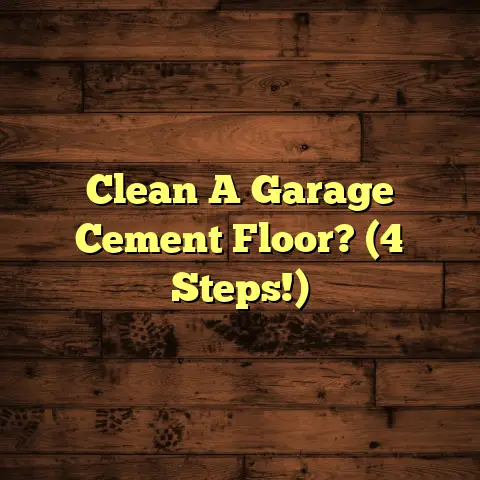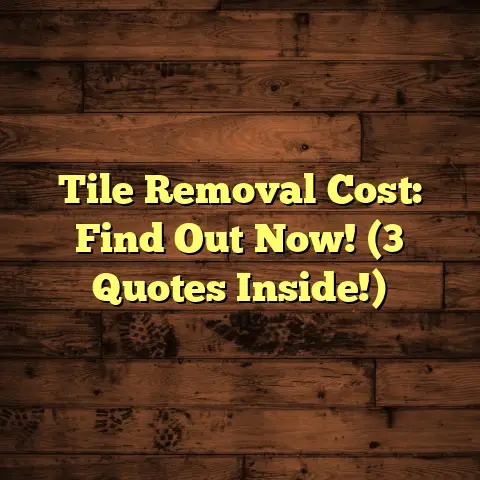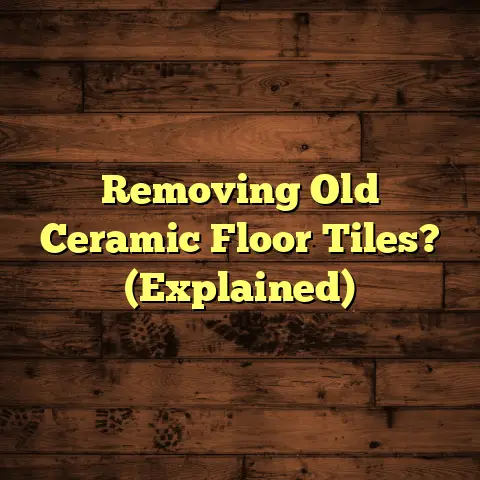Removing Laminate Residue: Guide (8 Easy Tips!)
Laminate flooring is like the reliable friend you can always count on. It’s been a popular choice for years, and for good reason. It’s affordable, comes in a ton of styles, and looks great. I’ve installed it in everything from cozy apartments to bustling office spaces.
But here’s the thing: even the most durable laminate isn’t invincible. Over time, it can accumulate dirt, grime, and, you guessed it, residue. Think of it like this: your favorite car needs a wash now and then, right? Your laminate floor is the same.
So, what exactly is laminate residue? Why does it matter? And, most importantly, how do you get rid of it? That’s what we’re going to dive into today. I’m going to share my go-to tips and tricks for keeping your laminate floors looking their best. Let’s get started!
Section 1: Understanding Laminate Residue
Okay, let’s break down what we’re dealing with.
1. What is Laminate Residue?
Laminate residue is basically any unwanted substance that sticks to your laminate floor. It’s that film, those sticky spots, or that overall dullness that makes your floor look less than its best.
Think of it as a build-up of various things:
-
Sticky substances: Spilled soda, syrup, or even just sugary drinks that weren’t cleaned up properly.
-
Dirt and grime: Everyday dirt tracked in from outside, mixed with cleaning product residue.
-
Oil marks: Foot traffic, especially in kitchens, can leave behind oily residues.
-
Adhesive residue: Left over from stickers, tape, or even protective films that were once on furniture.
This residue builds up over time, and it’s not always obvious at first. You might just notice your floors aren’t as shiny as they used to be, or that certain areas look a little dull.
2. Common Causes of Laminate Residue
So, how does this residue actually end up on your floors? Here are some common scenarios I see all the time:
-
Spills: This is the big one. Spilled juice, coffee, or even just water can leave behind residue if not cleaned up immediately. The sugars and minerals in these liquids can dry and become sticky.
-
Cleaning products: Ironically, some cleaning products can cause residue. Using too much soap, or using the wrong type of cleaner, can leave behind a film. I’ve seen this happen a lot with cleaners not specifically designed for laminate.
-
Furniture placement: Moving furniture around can leave behind scuff marks and residue from the furniture’s feet. Also, furniture pads can sometimes leave adhesive residue.
-
Foot traffic: This is just a general contributor. Over time, foot traffic grinds dirt and grime into the floor, creating a layer of residue.
-
Sticker and tape residue: Kids love stickers, right? But those stickers often end up on the floor, leaving behind a sticky mess. Tape used for temporary fixes can do the same.
The key takeaway here is that prompt cleaning is crucial. The longer a spill or mess sits, the harder it is to remove and the more likely it is to leave behind residue.
3. The Impact of Residue on Laminate Flooring
Okay, so residue isn’t just unsightly, it can actually damage your floors in the long run. Here’s how:
-
Aesthetic impacts: This is the most obvious. Residue makes your floors look dull, discolored, and generally unattractive. It can hide the natural beauty of the laminate and make your whole room look less appealing.
-
Discoloration: Certain types of residue, especially from spills, can actually stain the laminate over time. This can lead to permanent discoloration that’s impossible to remove.
-
Dullness: Residue can create a film that dulls the floor’s finish. This makes the floor look less shiny and vibrant.
-
Long-term damage: If left untreated, residue can actually damage the laminate surface. It can etch into the finish, making the floor more susceptible to scratches and wear.
-
Costly repairs: In severe cases, residue build-up can lead to the need for professional cleaning or even floor replacement. This can be a significant expense that could have been avoided with proper maintenance.
Think of it like plaque on your teeth. If you don’t brush regularly, the plaque builds up and can lead to cavities. Laminate residue is similar. Regular cleaning prevents build-up and protects the floor’s surface.
Section 2: Preparation for Cleaning
Before you start scrubbing away, let’s get organized. Proper preparation is key to effective and safe cleaning.
1. Gathering Necessary Tools and Materials
Here’s a list of essential cleaning supplies you’ll need:
-
Soft mop: A microfiber mop is ideal. Avoid mops with abrasive pads, as they can scratch the laminate.
-
Microfiber cloths: These are great for wiping up spills and applying cleaning solutions.
-
Gentle cleaners: Look for cleaners specifically designed for laminate floors. Avoid harsh chemicals like bleach or ammonia.
-
Warm water: This is often all you need for light cleaning.
-
Vinegar: A natural cleaner that can help remove residue.
-
Baking soda: A mild abrasive that can tackle stubborn stains.
-
Rubbing alcohol: For removing adhesive residue.
-
Spray bottle: For applying cleaning solutions.
-
Bucket: For holding water or cleaning solutions.
-
Doormats: To prevent dirt from being tracked onto the floor.
-
Furniture pads: To protect the floor from scratches.
When choosing cleaning products, always read the label carefully. Make sure the product is specifically designed for laminate floors and that it doesn’t contain any harsh chemicals. I’ve seen people ruin their floors by using the wrong type of cleaner.
2. Safety Precautions
Safety first! Here are some important precautions to keep in mind:
-
Test cleaning solutions: Before applying any cleaning solution to the entire floor, test it in an inconspicuous area, like under a piece of furniture. This will help ensure that the solution doesn’t damage or discolor the laminate.
-
Wear gloves: Some cleaning solutions can irritate your skin. Wearing gloves will protect your hands.
-
Ensure proper ventilation: When using cleaning agents, especially those with strong odors, make sure the room is well-ventilated. Open windows or turn on a fan.
-
Avoid excessive water: Laminate floors are water-resistant, but they’re not waterproof. Excessive water can seep into the seams and cause swelling or damage. Always use a damp mop, not a soaking wet one.
-
Keep children and pets away: While cleaning, keep children and pets away from the area to prevent accidents or exposure to cleaning agents.
3. Assessing the Level of Residue
Before you start cleaning, take a close look at your floor. How much residue is there? What type of residue is it? This will help you determine the best cleaning method.
-
Light residue: This is a thin film that makes the floor look slightly dull. It’s usually caused by everyday dirt and grime. Warm water and a microfiber cloth may be all you need.
-
Moderate residue: This is more noticeable and may include sticky spots or discoloration. You’ll likely need to use a cleaning solution like vinegar and water.
-
Heavy residue: This is a thick build-up of dirt, grime, or adhesive. You may need to use a stronger cleaning solution or even a steam cleaner.
-
Stubborn stains: These are isolated spots that are difficult to remove. You may need to use a specialized stain remover or a baking soda paste.
By assessing the level of residue, you can choose the most effective cleaning method and avoid using harsh chemicals unnecessarily.
Section 3: Easy Tips for Removing Laminate Residue
Alright, let’s get to the good stuff! Here are my top 8 tips for removing laminate residue:
Tip 1: Warm Water and Microfiber Cloth
This is the simplest and often most effective way to remove light residue.
-
How to do it: Dampen a microfiber cloth with warm water. Wring out the cloth so it’s not dripping wet. Gently wipe the floor in a circular motion. Rinse the cloth frequently and re-dampen with clean water.
-
Why it works: Warm water helps to loosen dirt and grime, while the microfiber cloth lifts it away without scratching the floor.
-
When to use it: For everyday cleaning and removing light residue.
-
My experience: I use this method almost daily in my own home. It’s quick, easy, and effective for keeping my laminate floors looking clean.
Tip 2: Vinegar Solution
Vinegar is a natural cleaner that can help remove residue and leave your floors looking shiny.
-
How to do it: Mix 1/2 cup of white vinegar with 1 gallon of warm water. Pour the solution into a spray bottle. Lightly spray the floor with the solution. Wipe the floor with a damp microfiber mop or cloth.
-
Why it works: Vinegar is a mild acid that helps to break down dirt and grime. It also helps to neutralize odors.
-
When to use it: For moderate residue and to add shine to your floors.
-
My experience: I’ve used vinegar solutions for years. It’s a great way to clean without harsh chemicals. Just be sure to dilute the vinegar properly, as undiluted vinegar can damage the laminate.
Tip 3: Baking Soda Paste
Baking soda is a mild abrasive that can help remove stubborn stains and residue.
-
How to do it: Mix baking soda with a small amount of water to create a paste. Apply the paste to the stain or residue. Let it sit for a few minutes. Gently scrub the area with a soft cloth or sponge. Rinse the area with clean water and dry with a clean cloth.
-
Why it works: Baking soda gently scrubs away the stain without scratching the laminate.
-
When to use it: For stubborn stains and residue that won’t come off with other methods.
-
My experience: I’ve used baking soda paste to remove everything from crayon marks to dried-on food. It’s a versatile and effective cleaner. Just be sure to rinse the area thoroughly after scrubbing.
Tip 4: Commercial Laminate Cleaners
There are many commercial cleaning products specifically designed for laminate floors.
-
How to do it: Follow the instructions on the product label. Typically, you’ll spray the cleaner onto the floor and wipe it with a damp mop or cloth.
-
Why it works: These cleaners are formulated to remove dirt and grime without damaging the laminate finish.
-
When to use it: For general cleaning and to maintain the floor’s shine.
-
My experience: I’ve tried many different commercial laminate cleaners over the years. Some are better than others. I recommend reading online reviews and choosing a cleaner that’s specifically designed for your type of laminate floor.
I personally use these commercial laminate cleaners from time to time:
- Bona Hardwood Floor Cleaner
- Weiman Hardwood Floor Cleaner
- Armstrong Hardwood and Laminate Floor Cleaner
Tip 5: Rubbing Alcohol for Stubborn Adhesive Residue
Rubbing alcohol is a great solvent for removing sticky residue left by labels or tape.
-
How to do it: Dampen a cotton ball or cloth with rubbing alcohol. Gently rub the adhesive residue until it dissolves. Wipe the area with a clean, damp cloth to remove any remaining alcohol.
-
Why it works: Rubbing alcohol breaks down the adhesive, making it easier to remove.
-
When to use it: For removing sticky residue from stickers, tape, or other adhesives.
-
My experience: I’ve used rubbing alcohol to remove stubborn sticker residue from countless floors. It’s a quick and effective solution. Just be sure to use it sparingly and wipe the area with a damp cloth afterward.
Tip 6: Olive Oil and Vinegar for Shine
This is a natural way to add shine to your laminate floors while also reducing residue.
-
How to do it: Mix 1/4 cup of olive oil with 1/2 cup of white vinegar in a spray bottle. Lightly spray the floor with the solution. Wipe the floor with a damp microfiber mop or cloth.
-
Why it works: Olive oil helps to condition the laminate and add shine, while vinegar helps to remove residue.
-
When to use it: To add shine to your floors and reduce residue.
-
My experience: This is a great option for those who prefer natural cleaning solutions. It leaves the floors looking shiny and new. Just be sure to use it sparingly, as too much olive oil can make the floors slippery.
Tip 7: Steam Cleaning for Deep Cleaning
Steam cleaning is a great way to deep clean your laminate floors and remove stubborn residue.
-
How to do it: Use a steam cleaner specifically designed for laminate floors. Follow the instructions on the steam cleaner. Typically, you’ll fill the steam cleaner with water and allow it to heat up. Then, you’ll move the steam cleaner over the floor in a slow, even motion.
-
Why it works: Steam cleaning uses hot steam to loosen dirt and grime, which is then lifted away by the steam cleaner’s pad.
-
When to use it: For deep cleaning and removing stubborn residue.
-
My experience: I’ve used steam cleaners on laminate floors with great success. However, it’s important to use a steam cleaner specifically designed for laminate floors and to follow the instructions carefully. Excessive heat or moisture can damage the laminate.
Tip 8: Regular Maintenance Tips
Prevention is always better than cure! Here are some tips for preventing residue build-up in the first place:
-
Use doormats: Place doormats at all entrances to your home to prevent dirt from being tracked onto the floor.
-
Sweep or vacuum regularly: Sweep or vacuum your floors regularly to remove dirt and debris.
-
Clean up spills immediately: Wipe up spills as soon as they happen to prevent them from drying and leaving behind residue.
-
Use furniture pads: Place furniture pads under the legs of your furniture to protect the floor from scratches and scuff marks.
-
Avoid wearing shoes indoors: Encourage family members and guests to remove their shoes before entering your home.
By following these simple maintenance tips, you can keep your laminate floors looking clean and new for years to come.
Section 4: Post-Cleaning Care
You’ve cleaned your floors, now what? Here’s how to ensure your hard work pays off in the long run.
1. Evaluating the Cleaned Area
Once you’ve finished cleaning, take a close look at the area you’ve cleaned.
-
Check for residue: Are there any remaining spots of residue? If so, you may need to repeat the cleaning process or try a different method.
-
Check for damage: Did the cleaning solution damage the laminate in any way? If so, you may need to consult with a flooring professional.
-
Check for shine: Does the floor look clean and shiny? If not, you may want to try a polishing solution.
2. Preventative Measures
The best way to keep your laminate floors looking great is to prevent residue build-up in the first place.
-
Routine Cleaning Schedules: Set up a regular cleaning schedule. This could involve sweeping or vacuuming weekly and mopping monthly. Consistency is key.
-
Protective Coatings: Consider applying a laminate floor protector or polish. These products can help to create a barrier against dirt and grime.
Some popular products include:
- Rejuvenate Laminate Floor Restorer and Polish
- Quick Shine Multi-Surface Floor Finish
-
Strategic Placement of Rugs: Place rugs in high-traffic areas, such as hallways and entryways, to protect the floor from wear and tear.
3. When to Seek Professional Help
Sometimes, despite your best efforts, you may need to call in a professional.
-
Extensive Damage: If the laminate is severely damaged or discolored, professional cleaning or repair may be necessary.
-
Large Areas: If you have a large area of laminate flooring that needs cleaning, it may be more efficient to hire a professional.
-
Specialized Equipment: Professionals have access to specialized equipment, such as industrial-strength steam cleaners, that can provide a deeper clean.
-
Peace of Mind: If you’re not comfortable cleaning your laminate floors yourself, hiring a professional can give you peace of mind.
Conclusion
So, there you have it! My top tips for removing laminate residue and keeping your floors looking their best.
Remember, regular maintenance and prompt cleaning are key to preventing residue build-up and extending the life of your laminate floors.
By following these easy tips, you can effectively remove laminate residue and enjoy beautiful, clean floors for years to come.
Don’t be afraid to experiment with different cleaning methods to find what works best for you and your floors. And most importantly, take pride in your laminate flooring and the simple steps you can take to care for it.
Happy cleaning!





